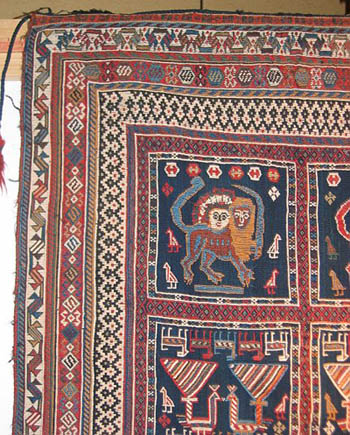The Salon du Tapis d'Orient is a moderated discussion group in the manner of the 19th century salon devoted to oriental rugs and textiles and all aspects of their appreciation. Please include your full name and e-mail address in your posting.
Saturday (continued)
Dear folks
The first session I attended on Saturday was Jeff Spurr's in which he made an argument about Lakai textiles. Jeff, together with some others, argues that what is often seen as representation in Central Asian pieces is actually geometric and that when representation is intended it is quite manifest. We will, ultimately be able to illustrate some of his points from images Fred Mushkat has taken of Jeff's exhibition (140 pieces). I also have his printed handout which also includes lots of explanatory details.
A second morning session for me was by Erik Risman, Peter Poullada and Kurt Munkacsi on "The Mystery of Ersari-Beshiri weavings."

Each of them presented but the basic argument was that there is no Beshiri tribe and that this usage should be avoided. That there were lots of Turkmen from various tribes along the Amu Darya and that some information is available about who they were and where they were located at least in the late 19th century. They drew on a book written in the 1950s which in turn drew on a kind of census done in 1920, the latter importantly by interviewing tribal leaders and old people. Jurg Rageth objected from the audience to what he saw as their omission of the historical context of this situation, that the Turkmen came into this area in perhaps the sixth century and that the people already there were of Indo-European background and likely already weaving. Jurg insisted that some influence of these older occupants of this area seemed likely and was being ignored in this argument.
Erik, Peter and Kurt all showed pieces trying to indicate what groupings might be identifiable and what distinctions might be made to date.

The afternoon session I attended was by Jim Burns, the Seattle collector, who talked about Persian "horse covers." The quotes indicate that there are varieties, some on the horse either to cushion the saddle or for decoration or for drying down after sweating and some are used on top of the saddle for decoration a cushioning.

Jim said this is a good area in which to collect because only the best materials and the best workmanship was used on these items. It is a bad area in which to collect because it's fairly hard to find some horse covers.
I have close pictures, even if they are not always well lighted.
The first is a Ferahan with a herati field design.

A second piece, Jim said, is a Persian military issue.

A third piece is a Malayer with a yellow ground.

The fourth piece is very unsual: a silk saddle cover.

Here is a closer look.

The next piece is from eastern Persia, a Khorassan cover larger (horses are larger in eastern Persia) and with the traditional jufti structure.

The next piece is an under the saddle cover, a Quashquai.

Beautiful drawing in its compartments.

Here below is Senneh piece with a herati field.

Jim said that Sennehs are among the most available horse trappings.
The piece below is the only kilim horse cover Jim showed.

It is a pictorial example
The last piece Jim showed is Shahsavan.

Nicely drawn horses and riders to make the point.

And an interesting dark but decorated back portion.

That is what I can give you on today's session.
There were auctions both at Skinner and in the evening at Grogan. We went to the Grogan event. Some pieces went for spectacularly high prices. One old but moth eaten Turkmen engsi went for $35,000 and a classic but worn Borjalou Kazak went for $60,000. Mr. Grogan did quite well and likely paid and more for his nice reception with wine and food.
That's the end of today's report from ACOR 8.
Regards,
R. John Howe